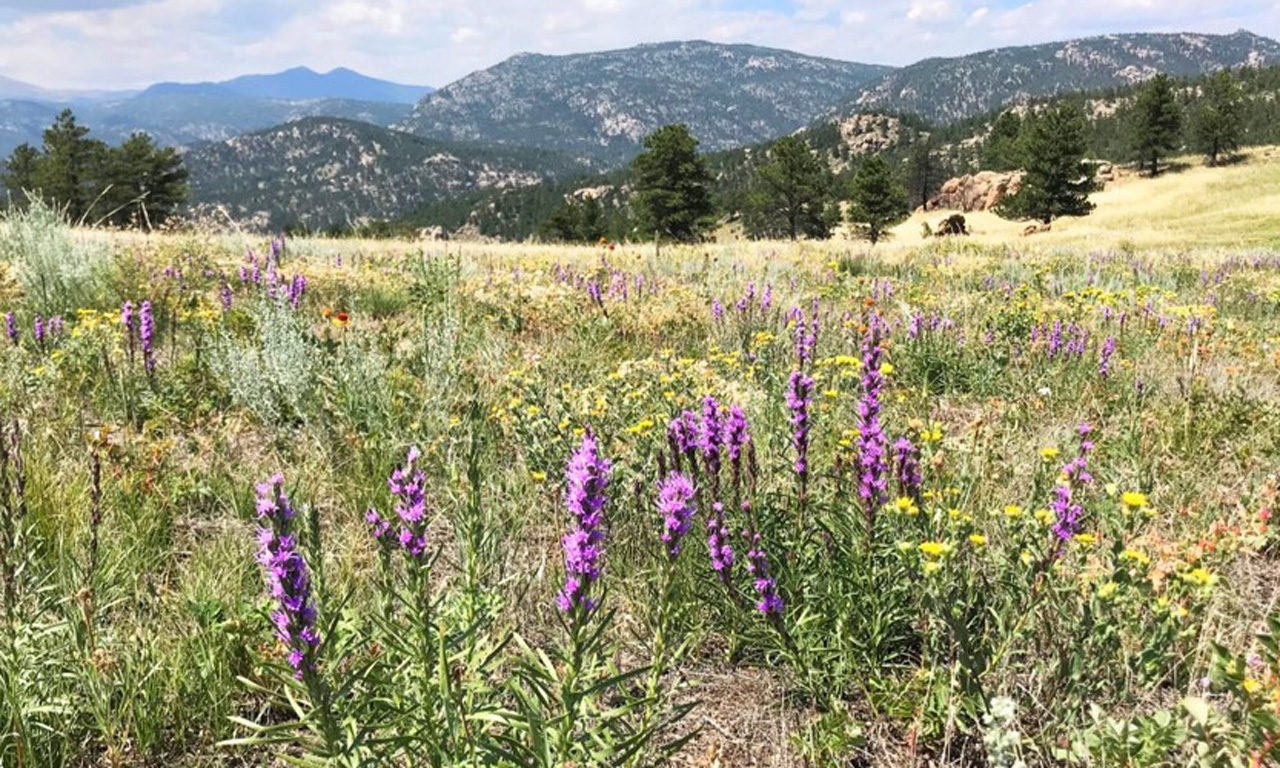When looking out over the grasslands that make up about half of Boulder County, you may notice clumps of maroon and gold grasses dotting the landscape, sometimes dominating the whole area. The plant is commonly known as cheatgrass; and although it has become a familiar sight in the West, it is not native to this region. Cheatgrass is responsible for much of the destruction of native ecosystems in the western United States. Boulder County actively manages this invasive grass with the hopes of restoring our ecosystems to a healthier state.
Cheatgrass (Bromus tectorum), also known as downy brome, is an annual grass native to Eurasia and the Mediterranean Basin. It can grow from about eight to 24 inches in height and has a characteristic drooping appearance after it flowers. The seeds are spiky and easily attach to boots and clothes, which helps the plant spread. Seeds typically germinate in the fall. The plant’s root system develops over the winter, helping it take advantage of the return of wet weather in the spring.
Cheatgrass and the Threats it Poses
Cheatgrass poses significant problems because it dominates ecosystems and increases the likelihood of wildfires. According to Steve Sauer, recently retired weed control supervisor for Parks & Open Space, the main issue with cheatgrass is that it outcompetes the desirable native grasses and forbs that provide forage for a variety of animals. One study, conducted by Sauer and his team, measured the biomass of areas that were treated for cheatgrass compared to non-treated areas. The study found that non-treated areas had about 49 lbs/acre of desirable plants, while treated areas had in excess of 1,000 lbs/acre of desirable foliage. By treating for cheatgrass, the department has helped return our open space lands to a more productive and viable natural state, which benefits plants, animals, and humans alike.
Wildfire is another threat posed by cheatgrass because it grows rapidly in the spring, but then dies off mid-May to June. Because cheatgrass grows in dense clusters, it becomes perfect fuel for the fire season. It thrives in burn areas, further out-competing native plants and creating a cycle of more common wildfires. By eliminating cheatgrass, fires may not move as quickly through an area.
Management Strategies
Management for cheatgrass can be done several ways. Mechanical treatments involve physically removing the plant by pulling or mowing it before the seeds appear. This method can help stall the spread of cheatgrass, but given how cheatgrass can take over acres of land, this method is ultimately ineffective. Another method is conducting a controlled burn. This tactic eliminates the grass stalks; but unless the fire burns hot enough, the seeds will remain in the soil.
Boulder County, in partnership with Colorado State University, developed a more effective means of controlling cheatgrass. Since 2014, the two agencies studied the effectiveness of different herbicides, examining them year after year. Since cheatgrass seeds can survive in the soil for three to five years, a successful herbicide must be able to target the soil seed bank in order to eliminate the species from an area. The studies found that the herbicide Rejuvra was the most successful at eliminating cheatgrass over a longer period. Rejuvra has been approved by the EPA and can be applied in areas where cattle graze and it won’t show up in the meat product. With such a prolific invasive species such as cheatgrass, Rejuvra has demonstrated that it is the most efficient way to control and eliminate its spread.
Through the safe and effective application of herbicides like Rejuvra, Boulder County has controlled the spread of cheatgrass in our parks and has restored native ecosystems. However, the battle with cheatgrass is far from over. The department will continue using the latest science and management practices to stop the spread of this invasive species.




